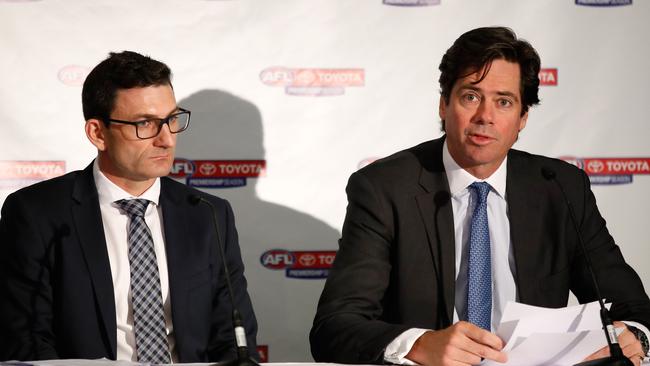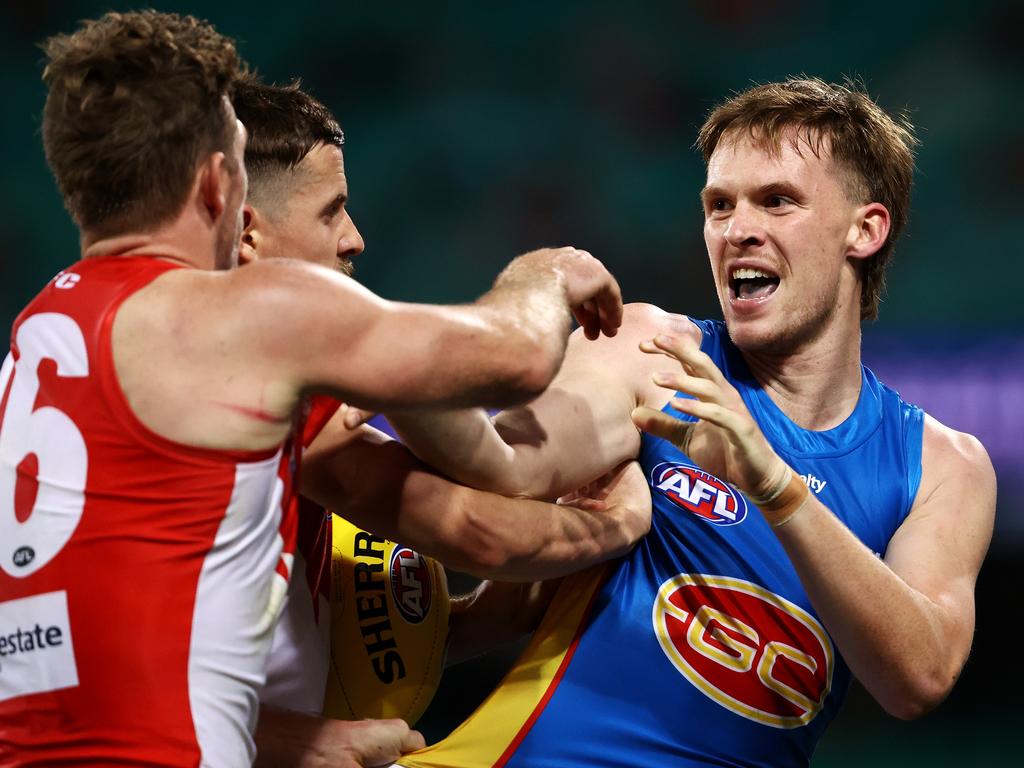How the AFL fashioned a fixture to keep season alive amid COVID chaos
AFL fixture boss Travis Auld and his team have been burning the midnight oil to keep the 2020 season progressing.

With coronavirus wreaking havoc in society, the AFL has somehow managed to keep its season afloat, but a recent query in a newspaper letter to the editor caused Travis Auld to chuckle.
Auld is the AFL’s chief financial officer and general manager of clubs and broadcasting. But in this season of perpetual flux, the media has adopted a simpler, abbreviated title: Travis Auld, AFL fixture boss.
Which prompted a query from a letter writer simply known as Rob, Mansfield, who could well be a serial pen-pal given the question has popped up on online forums as well.
“Can someone please enlighten me as to how much the AFL fixtures boss gets paid and what he does after the fixture is set? And can I apply for the job?” Rob wrote.
With the nightmarish challenges of 2020, it might be argued an administrator could not be paid enough to cope with the ever-changing landscape the crisis has presented this year.
Fair question Rob. I’ll get back to you... pic.twitter.com/6WozS7uGOQ
— Travis Auld (@trava) June 10, 2020
From the season shutdown in March to the resumption in June, from the creation of a Gold Coast hub to the abandonment of the state of Victoria, there has never been a season like it.
And to answer at least one of Rob’s questions, no, delivering an AFL season is not as simple as clicking a button on a computer in a normal season, let alone a COVID-afflicted year.
The past week has again been frantic for Auld and a team featuring Marcus King, the AFL’s head of broadcasting and scheduling, as the crisis continues to challenge Australia.
From Wednesday night, when reigning premiers Richmond plays the Bulldogs at Metricon Stadium, football will be played on 20 nights in succession throughout late July and August.
The Giants and Swans will play each other in Perth. Further afield, a new hub will be established in Cairns and there are plans afoot for the Northern Territory as well. All the while, the MCG and Marvel Stadium sit vacant.
Fans in Victoria may not be able to attend matches but they have been as eager to find out when and where their teams are playing as those coaching and managing the 18 clubs.
“Marcus King is the guy who drives it behind the scenes and he is incredibly competent with an extraordinary work ethic,” Auld told The Weekend Australian.
“It’s noticeable that the fixture has taken more of a front seat this year. Normally it is something that happens in the background.
“This year it has actually become a bit of a talking point and I think fans have actually enjoyed more regular announcements of fixtures and the flexibility, while it was put there to help us navigate all the challenges and the uncertainty in front of us, it has been interesting to see how fans have enjoyed the week-to-week, in some cases, release of games.
“You talk about the fixture, but if it wasn’t for the broader collaboration and support throughout the industry to change the rules to allow for compressed games, develop protocols, win the confidence of government and local communities, manage the logistics, book planes and set up hubs in hotels and work with the players, sponsors and clubs, then there would be no need for a fixture. It is the entire industry that has made the season work.”
A crisis can create opportunity and what has unfolded in 2020 is likely to influence thinking in coming seasons when it comes to the scheduling of matches. The league will have more data as to whether fans prefer Thursday nights to Monday nights, for example, or whether the Sunday night slot is a winner.
“There is a lot of responsibility that sits around fan access,” Auld said.
“This year has been a bit different because unfortunately we haven’t had the opportunity for fans to attend early on, so we have had the chance this year to do things differently and I think we should continue to see how those things perform through the year.
“That is where I think the opportunity is, to assess different structures and different timeslots.”
In a regular year, Auld and King burn the midnight oil from midway through September through to late October composing the fixture for the following season. From club chief executives barking orders to identifying opportunities to maximise attendance and television ratings to catering for sponsors and other interest groups, there is much to consider.
Auld, who was raised in Tatura in the Goulburn Valley, is well aware of the differing demands and desires of stakeholders.
Between stints working for the AFL, he was employed on the other side of the fence at Essendon and then Gold Coast, where he was the inaugural chief executive.
The AFL works in collaboration with a Canadian-based company called Optimal Planning Solutions that has produced fixtures for sports across the globe.
Creating a draw that provides integrity is the No 1 priority but the league must also be well aware of providing football fans with as much access as possible.
And celebrations are important. For example, there is a reason Gary Ablett played his 350th and Joel Selwood reached his 300-game milestone in a match played in Geelong. Sadly there were no fans for obvious reasons.
“In a normal year, that can be quite tricky,” Auld said.
“(The Canadian’s) feedback is that we are probably as complicated as any competition he deals with because we have so many constraints, so many clubs that play out of the one venue, unlike the US leagues, and we do really prioritise our fans. Overall that increases the complexity.
“The role Marcus and I have is to take a version that has been computer generated and add value, to use your knowledge by talking to the people around you as to what might be some really good match-ups, what might be some milestone games that are coming up, what might be some theme opportunities.”
An abridged 17-round season might seem simpler in an 18-team competition but with borders closing in, it has proven the opposite.
If a club has already played West Coast or Fremantle, for example, there is less reason to send them to a hub in Perth, but the AFL still has to find a way for them to play the other WA team.
“The further you get into a season, the more difficult that gets,” Auld said.
“It really is just about, in some ways, throwing out the rule book as to how we would normally prepare a fixture and being really open-minded about what might be the opportunities and how we can do things differently.”
More Coverage
Here it is, the fixture for rounds 9-12.
— AFL (@AFL) July 21, 2020
What game are you looking forward to watching during this busy period? pic.twitter.com/joIXYLkFuH








To join the conversation, please log in. Don't have an account? Register
Join the conversation, you are commenting as Logout